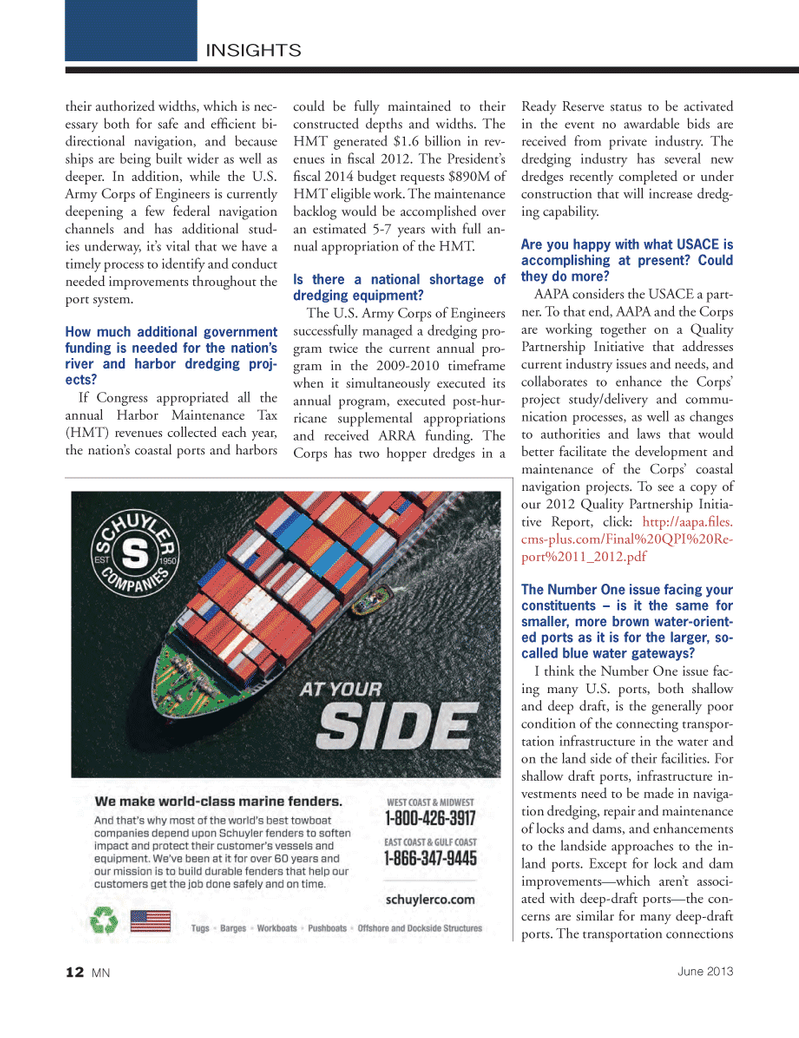
Page 12: of Marine News Magazine (June 2013)
Dredging & Marine Construction
Read this page in Pdf, Flash or Html5 edition of June 2013 Marine News Magazine
their authorized widths, which is nec- essary both for safe and efÞ cient bi- directional navigation, and because ships are being built wider as well as deeper. In addition, while the U.S. Army Corps of Engineers is currently deepening a few federal navigation channels and has additional stud-ies underway, itÕs vital that we have a timely process to identify and conduct needed improvements throughout the port system. How much additional government funding is needed for the nation?s river and harbor dredging proj- ects? If Congress appropriated all the annual Harbor Maintenance Tax (HMT) revenues collected each year, the nationÕs coastal ports and harbors could be fully maintained to their constructed depths and widths. The HMT generated $1.6 billion in rev- enues in Þ scal 2012. The PresidentÕs Þ scal 2014 budget requests $890M of HMT eligible work. The maintenance backlog would be accomplished over an estimated 5-7 years with full an- nual appropriation of the HMT. Is there a national shortage of dredging equipment? The U.S. Army Corps of Engineers successfully managed a dredging pro- gram twice the current annual pro- gram in the 2009-2010 timeframe when it simultaneously executed its annual program, executed post-hur- ricane supplemental appropriations and received ARRA funding. The Corps has two hopper dredges in a Ready Reserve status to be activated in the event no awardable bids are received from private industry. The dredging industry has several new dredges recently completed or under construction that will increase dredg- ing capability. Are you happy with what USACE is accomplishing at present? Could they do more? AAPA considers the USACE a part- ner. To that end, AAPA and the Corps are working together on a Quality Partnership Initiative that addresses current industry issues and needs, and collaborates to enhance the CorpsÕ project study/delivery and commu- nication processes, as well as changes to authorities and laws that would better facilitate the development and maintenance of the CorpsÕ coastal navigation projects. To see a copy of our 2012 Quality Partnership Initia- tive Report, click: http://aapa.Þ les.cms-plus.com/Final%20QPI%20Re- port%2011_2012.pdf The Number One issue facing your constituents ? is it the same for smaller, more brown water-orient- ed ports as it is for the larger, so- called blue water gateways? I think the Number One issue fac- ing many U.S. ports, both shallow and deep draft, is the generally poor condition of the connecting transpor-tation infrastructure in the water and on the land side of their facilities. For shallow draft ports, infrastructure in- vestments need to be made in naviga- tion dredging, repair and maintenance of locks and dams, and enhancements to the landside approaches to the in- land ports. Except for lock and dam improvementsÑwhich arenÕt associ- ated with deep-draft portsÑthe con- cerns are similar for many deep-draft ports. The transportation connections INSIGHTSJune 201312 MNMN June2013 Layout 1-17.indd 12MN June2013 Layout 1-17.indd 125/30/2013 11:05:10 AM5/30/2013 11:05:10 AM

 11
11

 13
13
